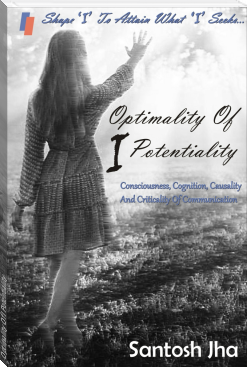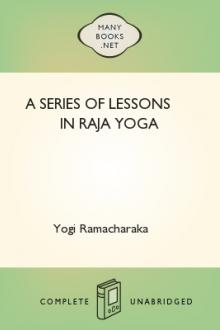Optimality Of I Potentiality by Santosh Jha (the reading list book TXT) 📕

Read free book «Optimality Of I Potentiality by Santosh Jha (the reading list book TXT) 📕» - read online or download for free at americanlibrarybooks.com
- Author: Santosh Jha
Read book online «Optimality Of I Potentiality by Santosh Jha (the reading list book TXT) 📕». Author - Santosh Jha
The ancient wisdom talked of the desirability of a higher consciousness in every person as chief aim of life and living. This was considered essential as only this state of higher consciousness or the ‘super consciousness’, could be a vehicle of larger wellness of the person and his or her personal excellence. The ancient Oriental wisdom said: There is a super consciousness within, evolved through discipline of body and mind, which enables the self (an individual) to decide the matrix of all decision-making of action-behavior, independent of the innate instincts and subconscious mind. Usually, for an untrained and unattained mind – an average person with no mind-training, it is either his or her instincts or the prevailing popular culture, which decides the benchmarks of right and wrong of any action/behavior and this happens almost unconsciously. However, one has to attain this facility of being the ‘conscious decider’ of what should ideally present oneself with his or her decision-matrix at any point of time in life.
For example, suppose, a man and a woman are madly in love with each other. The man in an emotional state, picks up a pebble from the riverbed and gifts it to his beloved saying, he is also like a pebble, non-egoistic yet unworthy. He says, ‘This pebble was once a huge rock, thousands of years back but after eroding and shedding its mass and bulk of undesired egoism, it has finally reduced to a well-rounded pebble with no sharp edges. I have also shed my egoism in my love for you and I give this pebble to you to symbolize this transformation’. The woman in extreme gesture of love says that she values it more than a diamond as it is given by the man she loves more than any possession of life.
The very emotion and idea which made the woman accept a pebble as more precious than diamond; inspired a worth and utility of value of a diamond in a useless pebble. The woman truly and deeply felt huge joy about its possession. This way, the woman’s ‘super conscious’ prevailed over her instinctive and cultured self, which would have otherwise thrown away the pebble in disgust. This state of consciousness engendered a novel matrix of a decision-making, independent of and beyond her intelligence, disposition and instinctive nature, which otherwise would never ever accept the utility of a pebble at par with a diamond.
Within our consciousness, there is a culture as well as an innate judgment mechanism, which usually assigns values and decides the utility of an entity. They would usually have decided that a pebble is worthless and a diamond is precious. However, the super consciousness of the woman in love overruled all fixed parameters of her conscious and subconscious minds and came forward as the ‘conscious decider’ of what should ideally present her with her decision-matrix at this point of time in life. Her super consciousness aligned with continuous and immortal intangible entity – intimacy and compassion in this case, renouncing the mortal value and utility of the tangible matter.
This is something available to humans only. This facility is our super conscious mind. This facility is essentially a function of imagination, which is duly supported by memories of experiences we have. Early humans succeeded in evolving fast and better by using their power of imagination to win over all obstacles. We have the facility to imagine ourselves out of the body and even out of the milieu to intangibly position ourselves in a situation, which is virtual and then weave possibilities to turn this virtual realism into a largely realistic one. In Indian spiritual philosophy, the ancestors prescribed a mechanism to be in exalted state of this super consciousness.
Science also explains the same mechanisms but uses different terms and frameworks. The Indian spiritual philosophy maintains that there is a continuous and complex interaction always going on between nature (external milieu) and human mind (internal milieu). It defines nature as drishya, something, which is seen and observed. It constitutes of two parts – the first being the tangible factors in external environment, which includes the contemporary culture, in which a human being lives. The second part is the intangible factors of body’s intrinsic nature or disposition. This intrinsic disposition has three attributes – sato gun (receptive mode), rajo gun (action mode) and tamo gun (inertia mode). These attributes suitably align with commensurate elements present in external milieus.
These three attributes are simultaneously present in all humans, even while different people may have different mix of the three attributes. Even science says, people can be identified as of a particular shade of consciousness, depending on amount and intensity the three attributes of reception, action and inertia in a person. One single person can be in different shades of consciousness, at different stages of life, as there are changes taking in the quotient of the three attributes. The society or larger physical milieu, we live in, also has these three attributes of reception, action and inertia.
It is self-evident that in a small and simple society, where material pursuits are very limited and small population naturally has larger proximity and intimacy between them, the predominant attribute of the milieu shall be reception. This shall make the society and its people in larger internal wellness but external discomfort.
However, in the unmanageably large and complex societies, we live today, where there is a deluge of material pursuits to attain, the predominant attribute of milieu shall be action and such societies, there shall be physical comforts for people but there shall be larger conflict and competitiveness among people in the society, economy and politics. In many societies, where physical comfort and personal attainments have become high, or in such societies where knowledge and development are miniscule, the predominant attribute shall be inertia. It is only natural and self-evident that such later societies shall have more conflicts, larger competitiveness, greater violence and less tolerance and stability but better external comforts. This is so self-evident for all of us.
Every attribute comes with an associated package of societal culture and individual behavior-action. A person living in a society where reception is predominant attribute shall behave differently than a person living in the society where predominant attribute is action or inertia. It is empirically observable to all that the drishya (nature or milieus) is a realism, which is in continuous change as the attributes and elements constituting it are mutually contradictory in nature. Modern psychology too accepts this. A person, who has a dominant consciousness of action, may eventually realize its futility and shall accept the utility of reception mode in later stage of life. A spendthrift may eventually start practicing the virtues of misery after indulging sometime in former mode. The vice-versa is also possible. The same is true with societies. It is our mechanism.
In many contemporary developed societies, like USA, the predominant attribute is action, even while large part of it has inertia, because of larger availability of comforts. It is only natural that many there are fed up with existing milieu and look for a life in reception mode. Many old developing societies, like India have largely been in the dominant attribute of reception. However, as material well-being is rising, it is going the old American way and now attributes of action and inertia are taking over. This change is cyclic with newer elements being introduced in every new cycle. This is why we all behave in a way, which a dominant culture prescribes to us. Societal personality becomes an overriding consciousness for most of us. The popular benchmarks become a rule for us. This is why ancient as well as contemporary wisdom tell us to rise above the populism and be your own conscious decision-maker.
Ancient Indian wisdom called the consciousness as drishta, a virtual agency, which sees and observes the intelligence of a person, which his or her current consciousness lands him or her in. The consciousness has been referred to as the observer of human intelligence, which decides the matrix for any decision of life, in the larger realism of drishya (nature and culture). The Indian spiritual philosophy observes that the drishya and drishta (nature and consciousness) are continuously interacting with each other in a cyclic causality, in which, each affects other and in turn gets affected. The randomly multidimensional juxtaposition of drishya and drishta (nature and consciousness) engenders different cyclical expressions of disposition. These cyclical expressions are infinite and all of them lead an individual to pains and troubles. This is because, these expressions link the ‘self’, the consciousness with discontinuous and immortal elements of drishya and drishta (nature and consciousness). The interaction of drishya and drishta (nature and consciousness) elements leads an individual to both gratification as well as renunciation. The Indian spiritual philosophy maintains that this cycle of gratification and renunciation is such a naturally intense and powerful realism that most people on earth remain attracted to it and become a part of the cyclic drift.
To come out of this cyclic causality of gratification and renunciation, which takes one away and aloof from this powerful drift is the role and function of this super consciousness. This is the difficult part of the entire idea of consciousness. This is probably an idea, which is tough for the consciousness to imagine. The practice of it is far more difficult. The yoga philosophy says, there is a state of super consciousness, which is called ‘Kaivalya’. This Sanskrit word has almost no parallel word in modern languages. We can say, it literally means a state of singleness, a conscious position of Onlyness.
For most of us, it is difficult to understand its true meaning as since long; we have been accustomed to collective and mutual existence and awareness of self. There is so much of contemporary culture within our conscious and subconscious minds. We are so used to our consciousness in complete collaboration and concomitance with our external as well as internal milieus that for us, an idea in the domain of total and perfect singleness and onlyness is beyond even imagination. The idea, as elaborated by Indian spiritual philosophy enshrines that super consciousness is a state of being, where there is complete and perfect lack of any connection, causality and coexistence between the drishta and drishya. The subject, the consciousness, which observes the nature and the decision-making matrices of life, becomes completely free and detached from the causality and utility of external as well as internal milieus and nature. This super consciousness is a state of singleness and onlyness – the kaivalya state of consciousness.
The idea is – in both the consciousnesses of gratification as well as renunciation, if there is causality and utility of the subject with object, the consciousness acquires the element of ego and sense of self, as distinct and different from others. This ego has to go in the state of super consciousness, as this element of sense of self is actually a mortal and discontinuous element. Kaivalya is a state of consciousness, which is devoid of ego and sense of self as this state is the true element of immortality and continuity. The singleness and onlyness has only a singular element of continuity and immortality. This sense of self needs to go away then only one can truly attain the state of kaivalya, the state of singleness and onlyness.
This is





Comments (0)